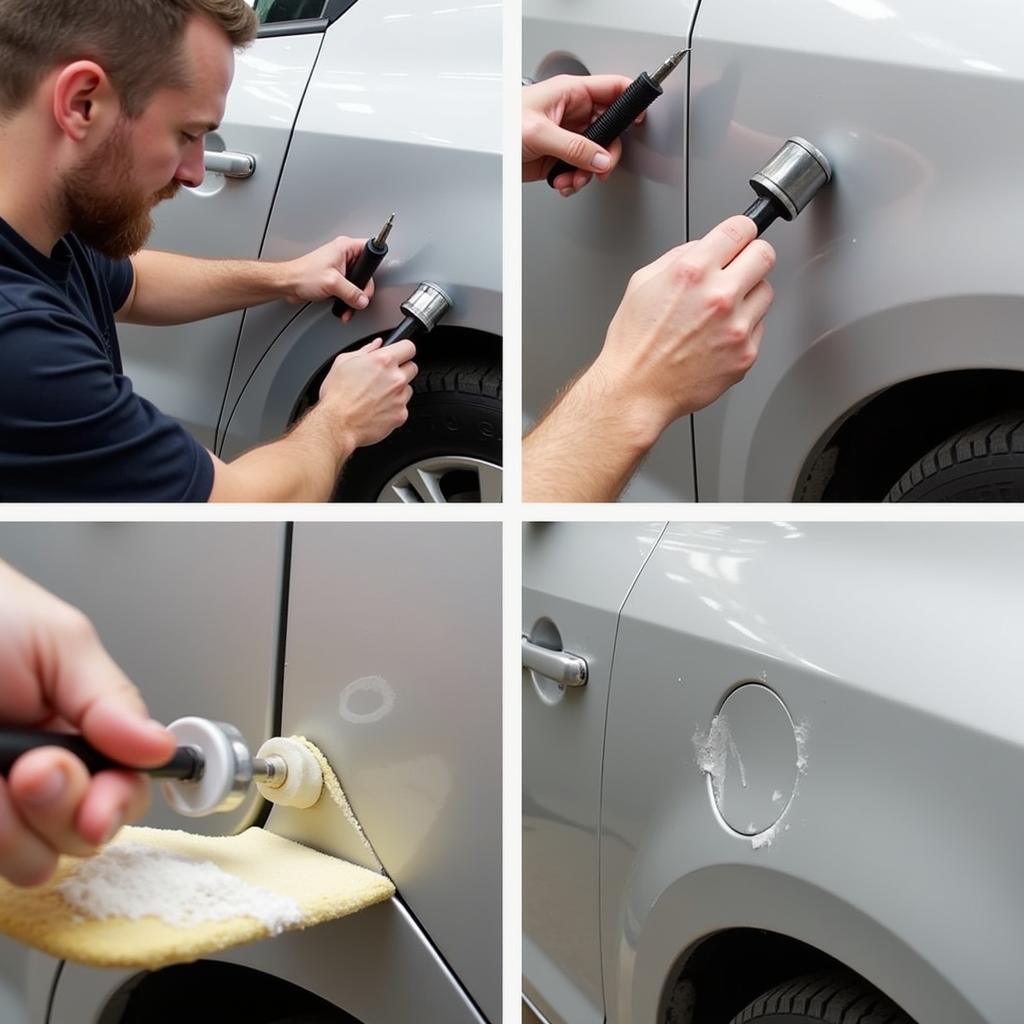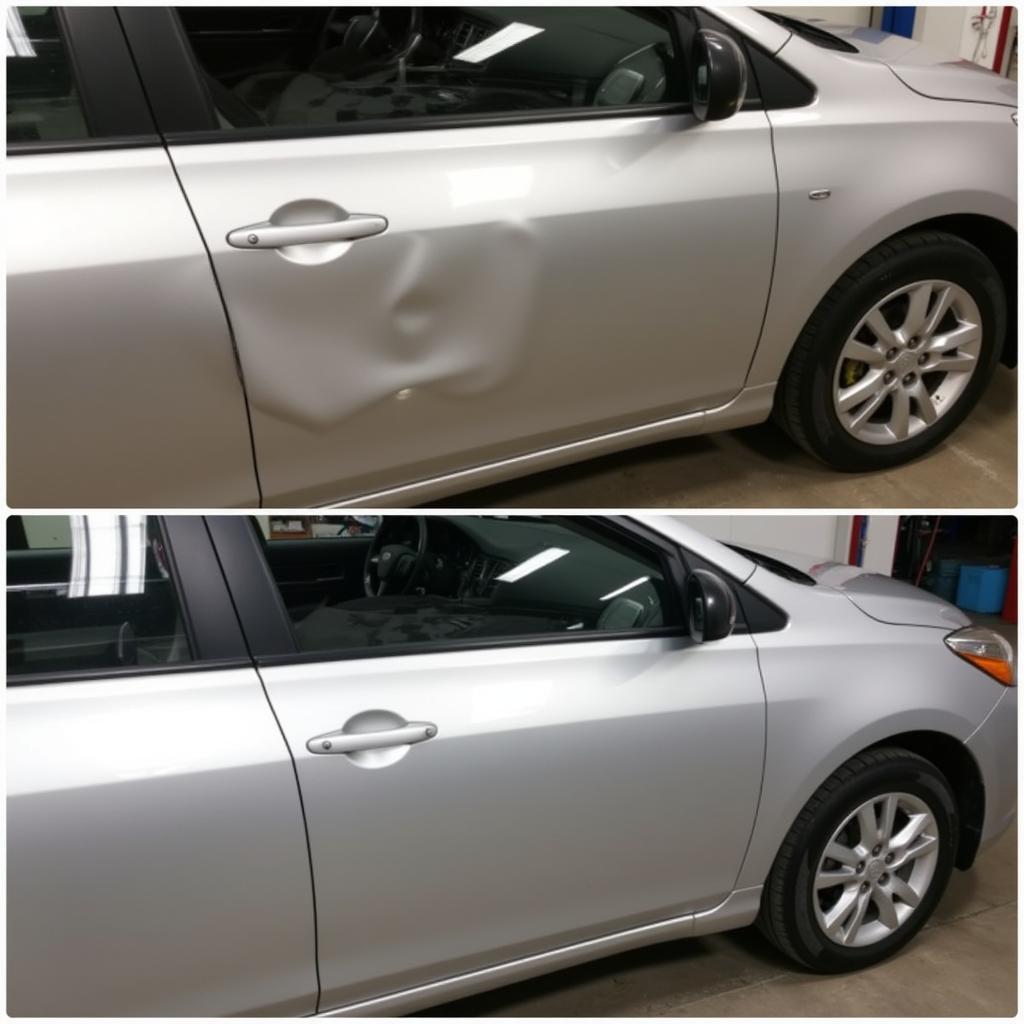Deep dents in your car can be an eyesore and can even affect the resale value. Fortunately, you don’t always need a professional body shop to fix them. This guide will take you through various methods for How To Fix Deep Dents In Car, from DIY solutions to professional repairs, empowering you to choose the best approach for your situation.
Similar to fixing body paint on car, addressing dents promptly can prevent further damage and rust. Understanding the different types of dents and repair methods is crucial for a successful outcome. Minor dents and dings can often be tackled with paintless dent repair (PDR) techniques, saving both time and money. However, deep dents often require more involved methods due to the extent of metal deformation.
Assessing the Damage: What Kind of Dent Are You Dealing With?
Before you start fixing a deep dent in car, you need to understand the damage. Is the paint cracked or chipped? Is the metal creased? This will help determine the best course of action. A simple dent with intact paint might be a candidate for DIY repair, while a dent with cracked paint or sharp creases might require professional intervention.
What if the dent is accompanied by a scratch? In cases where the dent has broken the paint, you’ll also need to address the paint damage after the dent is repaired to prevent rust. This might involve sanding, priming, and repainting the affected area.
DIY Methods for Fixing Deep Dents in Car
For those willing to try a DIY approach, several methods can be effective for fixing deep dents in car without professional help. These methods require patience and careful execution but can save you a significant amount of money. Remember, DIY methods are typically best suited for dents where the paint is still intact and the metal isn’t severely creased.
The Plunger Method: Simple and Effective
Using a suction cup plunger can often pull out shallow to moderately deep dents. This method is straightforward: wet both the plunger and the dented area, apply the plunger firmly, and pull straight out. This method requires a specialized dent puller plunger for best results.
The Hair Dryer and Compressed Air Method: Utilizing Temperature Changes
This method involves heating the dented area with a hairdryer and then quickly cooling it with compressed air (often in a can, available for electronics cleaning). The rapid temperature change can sometimes cause the metal to pop back into place. This method is best for smaller, less severe dents and requires caution to avoid damaging the paint. How much is it to fix car paint if it gets damaged? That’s another factor to consider.
Glue Pulling: A More Controlled Approach
Glue pulling kits are available online and in auto parts stores. These kits use specialized glue sticks and tabs that adhere to the dent, allowing you to pull it out using a slide hammer or similar tool. This method provides more control than a plunger and can be effective for deeper dents.
When to Call a Professional: Knowing Your Limits
While DIY methods can be effective for some dents, there are situations where professional help is essential. If the dent is extremely deep, has sharp creases, or has caused the paint to crack or chip, it’s best to consult a professional. Similarly, if the dent is in a difficult-to-reach area, professional expertise might be required. Black man fixing car, a skilled technician, can address complex repairs with specialized tools.
Professional Dent Repair Methods: Understanding the Options
Professional body shops employ several advanced techniques for fixing deep dents in car. These methods deliver high-quality results but typically come with a higher cost.
Paintless Dent Repair (PDR): The Go-To for Many Dents
PDR is a technique that involves using specialized tools to massage the dent out from behind the panel. This method preserves the original paint and is often faster and less expensive than traditional bodywork. However, PDR is not always suitable for extremely deep or creased dents. You can learn more about the average cost to fix dented car door.
Traditional Bodywork: For More Severe Damage
For dents that are too severe for PDR, traditional bodywork is necessary. This involves filling the dent with body filler, sanding it smooth, and then repainting the area. While this method is effective for even the most severe dents, it is more time-consuming and expensive than PDR.
 Professional Dent Repair Process
Professional Dent Repair Process
Preventing Future Dents: Protecting Your Investment
Preventing dents altogether is the best approach. Parking strategically, avoiding crowded parking lots, and being mindful of opening car doors in tight spaces can significantly reduce the risk of dents. Consider installing door edge guards to protect your car and others from accidental dings. Thinking about car fixing classes might empower you with preventative maintenance knowledge.
Conclusion: Choosing the Right Path for Your Dent Repair
Fixing deep dents in car requires careful consideration of the damage and the available repair methods. From DIY solutions for minor dents to professional techniques for more severe damage, there’s a solution for every situation. By carefully assessing the dent and understanding the available options, you can make an informed decision that restores your car’s appearance and preserves its value. For further assistance or a personalized consultation, please don’t hesitate to connect with us at AutoTipPro. Call us at +1 (641) 206-8880 or visit our office at 500 N St Mary’s St, San Antonio, TX 78205, United States. We are here to help you get your car back in top shape!
 Car After Dent Repair
Car After Dent Repair
FAQ
- Can I fix a deep dent myself? Yes, some deep dents can be fixed with DIY methods, especially if the paint isn’t damaged.
- How much does professional dent repair cost? The cost varies depending on the severity of the dent and the repair method used. Contact a professional for a quote.
- Is PDR always effective? PDR is very effective for many dents, but it’s not always suitable for extremely deep or creased dents.
- How can I prevent dents in my car? Park strategically, avoid crowded parking lots, and consider using door edge guards.
- What should I do if the paint is cracked around the dent? If the paint is cracked, it’s essential to address the paint damage after the dent repair to prevent rust. This might require professional assistance.
- Can a plunger fix a deep dent? A plunger might work for some moderately deep dents, but it’s less likely to be effective on very deep or creased dents.
- What are the risks of DIY dent repair? If done incorrectly, DIY dent repair could potentially worsen the damage or damage the paint.





Leave a Reply